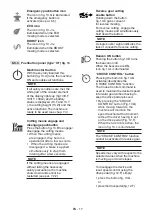
EN - 12
3.
Close the grass catcher (fig. 11.C)
by keeping the collection bag closing
button pressed (fig. 13.V).
NOTE
To remove the grass catcher (fig. 11.C), lift it in
such a way as to maintain a distance from the
plate of about 10 ÷ 15 cm, as shown in fig. 11.
6. CONTROLS
6.1 KEY IGNITION SWITCH
This key-operated command serves
as the main switch to enable or dis-
enable the machine's ignition circuit.
The key-operated switched
(fig.
12.A) has 2 positions:
1. Key removed.
The power circuit is
disabled and the machine turns off.
No function can be activated.
2. Key fully inserted.
the machine
is ready to be turned ON.
6.2 DRIVE PEDAL
The drive pedal (Fig. 12.A.) activates
wheel drive and adjusts machine speed
in forward and reverse gears.
1. Forward drive gear:
by
pressing the pedal forwards,
the machine advances.
Increasing the pressure on the
pedal progressively increases
the speed of the machine.
2. Reverse drive gear:
by
pressing the pedal backwards,
the machine moves in reverse
gear. Reducing the pressure on
the pedal progressively reduces
the speed of the machine.
3. Parking:
when the pedal is
released, a service brake
engages automatically which
serves to decelerate and
stop the machine, preventing
any additional movement
until the drive pedal is
once again pressed.
NOTE
The drive pedal deactivates when
the operator leaves the seat;
6.3 TRANSMISSION ENGAGEMENT
/ DISENGAGEMENT LEVER
The transmission engagement/disengagement
lever (Fig. 12.E
) allows the machine to
be moved manually (pushed or towed)
without having to switch on the machine.
This command has two positions,
indicated by the following symbols:
1. Drive engaged :
move the lever
(
fig. 12.H
) into the horizontal
position (A).
The machine
can be moved normally by
starting the machine
.
2. Transmission disengaged:
move the lever
(
fig. 12.H
)
downwards (B).
The
machine
can be moved manually without
having to start the machine
.
WARNING
Only move the machine manually
on a level surface.
SAFETY INSTRUCTION
The engagement/disengagement lever
must never be in the intermediate position.
This condition will cause overheating
and damage the transmission.
6.4 CUTTING HEIGHT ADJUSTMENT
6.4.1 Adjustment lever (
only for
models of type “I” and “II”
)
This lever (fig. 12.G) is used to raise and lower
the cutting means assembly, which may be
positioned at 7 different cutting heights.
The seven positions for this lever,
shown as «1» to «7» on the label,
correspond to various cutting
heights between 3 and 8 cm.
To move from one position to
another, the lever must be moved
sideways and repositioned in
one of the stop notches.
Summary of Contents for MPST 84 Li 48 V1
Page 2: ......
Page 5: ...F A E G H C B A D E F G A H C B A D B C C A 4 3 I II ...
Page 6: ...A C C B OK NO A B C D D E F F G G B 2 A C B 2 A D C B D 1 E D E 1 A B B 1 B B 5 I II 6 ...
Page 7: ...A B B A 8 7 9 ...
Page 8: ...A B C C D D H H E G F G F E 5 H H I I I I J K O N L O N M 10 15 cm A A C B III 10 11 ...
Page 10: ...1 3 A B A A A C B 14 15 16 17 18 19 20 ...
Page 11: ...I II A A B A 1 B A D C B A E TEST BEFO RE USE TEST RESET 22 23 21 25 24 ...
Page 12: ...A 28 A 26 A H H 30 mm H 10 mm H 20 mm H 0 mm 27 A C B D A C B A H 29 30 ...
Page 13: ...31 A A B C 180 mm 110 mm 32 33 ...
Page 14: ...38 B A C C 39 A D B C A A B C 110 mm 34 35 A A 36 37 ...
Page 15: ...42 A B C D D 41 43 40 A B I II ...
Page 16: ...A1 A2 B D C H J F I E m a x 2 4 5 N 2 5 k g m a x 9 8 0 N 1 0 0 k g C G K 44 ...
Page 223: ......
Page 224: ...ST S p A Via del Lavoro 6 31033 Castelfranco Veneto TV ITALY dB LWA Type s n Art N ...
















































